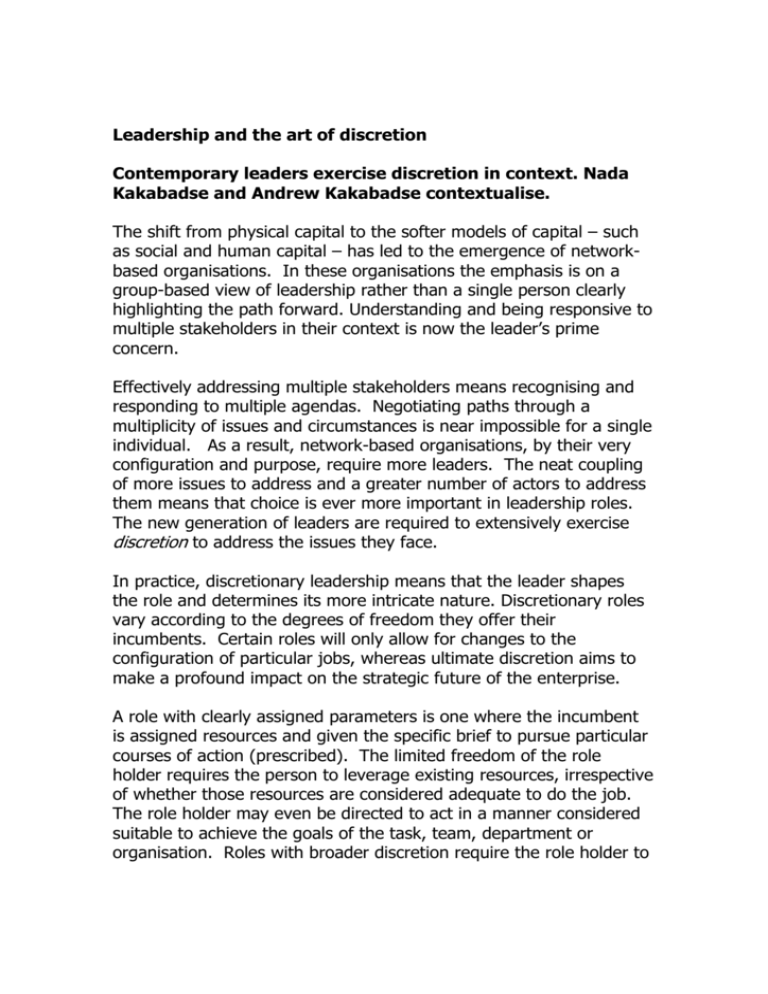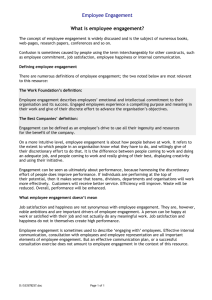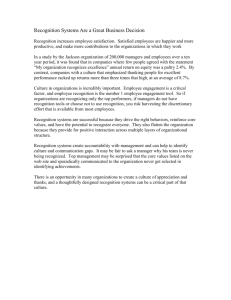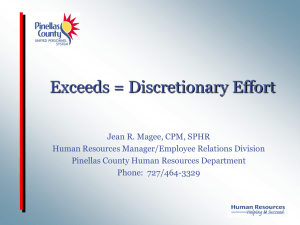Leadership and the art of discretion Contemporary leaders exercise
advertisement

Leadership and the art of discretion Contemporary leaders exercise discretion in context. Nada Kakabadse and Andrew Kakabadse contextualise. The shift from physical capital to the softer models of capital – such as social and human capital – has led to the emergence of networkbased organisations. In these organisations the emphasis is on a group-based view of leadership rather than a single person clearly highlighting the path forward. Understanding and being responsive to multiple stakeholders in their context is now the leader’s prime concern. Effectively addressing multiple stakeholders means recognising and responding to multiple agendas. Negotiating paths through a multiplicity of issues and circumstances is near impossible for a single individual. As a result, network-based organisations, by their very configuration and purpose, require more leaders. The neat coupling of more issues to address and a greater number of actors to address them means that choice is ever more important in leadership roles. The new generation of leaders are required to extensively exercise discretion to address the issues they face. In practice, discretionary leadership means that the leader shapes the role and determines its more intricate nature. Discretionary roles vary according to the degrees of freedom they offer their incumbents. Certain roles will only allow for changes to the configuration of particular jobs, whereas ultimate discretion aims to make a profound impact on the strategic future of the enterprise. A role with clearly assigned parameters is one where the incumbent is assigned resources and given the specific brief to pursue particular courses of action (prescribed). The limited freedom of the role holder requires the person to leverage existing resources, irrespective of whether those resources are considered adequate to do the job. The role holder may even be directed to act in a manner considered suitable to achieve the goals of the task, team, department or organisation. Roles with broader discretion require the role holder to establish the parameters of the role, the direction they are to pursue and to be responsive to the circumstances they face. Ultimately, discretionary roles are those positions for which organisationally beneficial behaviours and gestures can neither be enforced on the basis of formal role obligation nor elicited by contractual guarantee or reward. In response to the pace and pressure of organisational change, the nature of discretionary boundaries is increasingly determined by personal views, concerning the challenges leaders face and the nature of those with whom they interact. The idiosyncratic nature of the organisation, the peculiarities of each leadership role and the characteristics of the individual, are critical considerations in determining role boundaries and parameters. Indeed, making such a distinction illustrates that those with a broader role remit are in a position to substantially influence their situation. Further, the number of discretionary roles that exist in an organisation determines the number of visions and ways of operating that can shape, positively or negatively, the future of the enterprise. The greater the number of discretionary roles, the greater the number of visions that can be pursued and the greater the leadership challenge. Accordingly, leaders exercising their discretion are required to perpetually, deliberately and reflexively consider the nature of the linkages that connects their every action. Leadership is not just concerned with the exercise of control and co-ordination in the pursuit of a particular direction, but also with a sensitive understanding of the context in which actions are exercised and the appropriate mobilisation of others, in essence, the generation of social capital. Through so doing, the shape of organisations, supported by technological systems are increasingly designed around intellectual flows rather than configurations of command, where performance measures and incentive systems reward individuals for the creation of value. 1 For the flatter, more network-based organisation, which, by nature, houses a greater number of discretionary roles, the need to promote positive interdependency, is paramount. Responding to multiple stakeholders’ requirements obviates identifying the one best way to manage. Only through nurturing a shared value system are the tensions inherent in the network-based enterprise minimised and that energy focused towards achieving positive ends. However, where discretionary role analysis highlights variation of experience, capability, values, personality, behaviours and the exercise of choice amongst the leaders of the organisation, tension and conflict become endemic with potentially disastrous consequences for individuals and the organisation. Where continuous tension and an evolving but negatively inclined organisational landscape become the norm, leaders, particularly within network-based organisations, require an overarching analytical perspective that can comprehend the totality of the state of the organisation and yet, simultaneously, understand the nature of each interaction within the enterprise. A first step towards such enlightenment is to appreciate the level of migration from the control/transactional model of leadership to that of discretionary leadership which can induce a transformational impact (Table 1). As the effectiveness of organisational performance considerably rests on the quality of interactions, communication and co-ordination between stakeholders, leaders will be challenged to share their leadership and, as a result, will need to enhance their maturity in order to effectively share authority and responsibility across the leadership cadre. Ever greater innovation in ICT and the growing globalisation of trade will further induce the proliferation of networked organisations of alliances, emphasising joint ventures based on collaboration and dependent on situational authority. The new-age-capabilities of pursuing multiple dialogues simultaneously, namely, polylogues and co-creating value, are posited as becoming fundamental elements of organisational functioning. Shifting mindsets 2 The switch from the charismatic leader model of communication – focused on selling a vision and getting buy-in from followers -- to that of discretionary leadership which aims to influence the mindset of others in the network and shift towards a shared philosophy, requires movement from singularly created meanings to co-created meanings (Table 2). The leader needs to be an active listener in order to gain the necessary understanding of follower needs and use that insight to shape the vision in a fashion that appeals and inspires followers. Such bonding and bridging of social capital in order to promote a shared philosophy, not only depends on the leaders’ cognitive phenol type but also on the social time devoted to addressing the formal and tacit relational dimensions within the organisation. Open information organisations are characterised by lateral and horizontal patterns of exchange, interdependent flows of resources and reciprocal lines of communications. The diverse interests and priorities of varying stakeholders requires the discretionary leader to navigate through a multiplicity of interests, identifying shared commonalities and ensuring that benefit is derived from participation. Dialogue, a form of communication between two actors, is insufficient when sense making conversations are simultaneously required across multiple actors. Thus, dialogue is substituted by polylogue or multilogue. Within polylogue communication, conversations abound, at times being experienced as productive and other times, being viewed as repetitive and fruitless. Emotionally and contextually driven conversations require reinforcement, often involving repetition of the same conversation, as much to help individuals face their challenges as to provide them with insights to better enable them to move forward. Providing support, displaying empathy to others, making allowance for people to express their frustrations and going over the same issues to that each individual can gain a greater understanding of the issues facing them, can be perceived as pointless repetition. Reinforcing messages can also, unfortunately, lead to unproductive repetition. However, through greater intimacy of appreciation of each stakeholder and by judging the degree to which a new 3 convergence of opinion emerges, a breakthrough in terms of mindset shift can be achieved. As polylogue requires ceaseless conversations, negotiations, compromise, mutual exploration and inquiry, where the range of participants encompassed not only covers the trusted, but also “strange and alien voices”, it is critical to also achieve closure on discussions through establishing a new platform of awareness reinforcing the changed mindset. The challenge of achieving closure is clearly identified by Cary Cooper who remarks “inclusive doesn’t mean being touchy feely” and continues that shared and inclusive leadership equally has little to do with popularity. Once established, the philosophical platform enables integration of contrasting perspectives, such as, concern for others (people), economic efficiency (profit), environmental care (planet) and establishing an environment conducive for future generations (posterity). The discretionary leader’s challenge is to promote a polylogue environment by providing intellectual as well as process contributions. Teams become as much units of action as learning groups, whereby, reflection on experience and learning, combined with action, are accepted as an everyday norm. Adopting a polylogue mindset better enables the community to address and discuss the undiscussable issues that require open examination. Thus, the discretionary leader promotes a value trajectory, in which participatory methods used for debate and procedures and tools for guiding debate, form as much the leadership kitbag of skills as do fiduciary and accountability mechanisms, a point supported by research examining policy application effectiveness in government which concludes that leadership has to be considered as a pluralist activity and not an individual cluster of qualities and requirements. The responsibility Individuals who find themselves in a leadership position bear responsibility for the moral state of their constituency. Such responsibility does not solely require establishing the leader’s values. Moral effectiveness requires balancing and, if possible, integrating the 4 constituent members’ desires and perspectives, and emerging with a collective sense of moral integrity and responsibility. Such considerations are particularly critical in today’s complex organisations where leadership is shared. Certain individuals promote leadership from the centre, others hold leadership responsibility on a country or regional basis, still others on a functional/professional basis and yet others have a line of business or product or service responsibility. Simply because leadership responsibilities and accountabilities are shared does not mean a sharing of philosophy, objectives, attitudes or even mission and vision for the organisation. On the basis that the greater the number of leaders potentially the greater dissonance, the requirement for polylogue-based communication is heightened. Otherwise the erosion and tearing of the social and economic fabric of organisations will become an everyday experience. The balance lies between desire and a personal sense of responsibility; between the demands of economies of scale and the social needs of the community. Responding to the economic realities confronting leaders, balanced against providing a sense of care for the community are paradoxes that any one individual would be unduly challenged to reconcile. Thus, the need for the discretionary leader to co-create futures with others, through involvement and continuous examination of ways forward, balancing short-term, operational demands captured in the accountabilities that confront each leader against attending to the sustainable development of the enterprise. Thus, the philosophy of shareholder wealth is impregnated by the philosophy of stakeholder development. Polylogue, the desired philosophy of communication underpinning discretionary leadership, requires the suspension of judgement until the other’s point of view has been examined and reflection over one’s own practice has been undertaken. Discretionary leadership adopts the Socrates perspective of the examined life - “an unexamined life is not work having” - and only through such enrichment, can all jointly progress beyond leader/follower and shareholder wealth, to shared responsibility and enterprise and community sustainability. Resources 5 Bass, B. M. (1990), Bass and Stogdill's handbook of leadership: Theory, research and managerial applications, 3rd ed., Free Press. Bennis, W. (1989), Why Leaders Can't Lead, Jossey-Bass. Block, P. (1996), Stewardship, Berrett-Koehler Publishers. Fairholm, G. W. (1991), Values Leadership: Towards a New Philosophy of Leadership, Praeger. Gergen, K. J. (2000), The Saturated Self: Dilemmas of Identity in Contemporary Life. Basic Books, New York. Khurana, R. (2002), “The curse of the superstar”, Harvard Business Review, September. Lin, N. (2001), Social capital: A theory of social structure and action. Cambridge University Press. Tichy, N. M. and Devanna, M. A. (1986), “The transformational leader”, Sloan Management Review, July. Nada Kakabadse (nada.kakabadse@northampton.ac.uk) is a professor of management and business research at Northampton Business School. She is the co-author of Essence of Leadership (1999) and The Geopolitics of Governance (2000). Andrew Kakabadse (a.p.Kakabadse@cranfield.ac.uk) is a professor of international management development at Cranfield School of Management. 6 Table 1: Migration of leadership models Characteristics Control/Transactional Transformational Discretionary Projected image • • • • • • • • • Hero • • • Professional executive • Leader (individual) • Leadership cadre • Leader/followers relationship (e.g. followers’ identification with the leader) • Role discretion contextually defined (e.g. shared power) • Development organisation • • • Emotionally mature • • • • Responsible • • • • Influencer • • • Co-create differentiation “Strong Man” Rational Man Omnipresent Superman (Ubermensch) “Maverick” Athlete Omnipotent • Manager (individual) Conceptualise d as • Leader/followers relationship “instrumental relationship”) Emphasis on • Power and control • Extraordinariness leader Attributes • • • Powerful • • Charismatic Energetic/virile • • • • • Initiator of structure • • • • • • • • • • • Good listener • • Provide vision/focus Key tasks Autocratic Directive (e.g. path-goal setter) Disciplinarian Punitive Task Oriented Consolidator • • • • Planning (charting) Key needs • Impact Resources mobilisation Organising (structuring) Controlling Distributed Merlin Metaphor (e.g. Co-creator of Restless/dissatisfied with the status quo Risk taker Fighter Action oriented/potent Visionary Determined Communicator “Rational” (logical, practical) a Passionate of others/ Reflexive decision maker Mindful of self, others and society Accountable Networked Communicative (engaged in polylogue) Negotiator of paradoxes Inquiring learner Coach/developer of intellectual and social capital Alliance builder Challenge status quo /impetus for change Change mindset Co-create beliefs • • Stimulate and inspire Skills • Competence • Capability • Transactional • Transformational • Contextual (transactionally and transformationally) appropriate • Physical capital (reflected by tools, machines) • Physical capital (reflected by portfolio investment) • • Human capital (reflected • Human capital (reflected Social capital (reflected by existence of close interpersonal relationships Reviewing Empower others 7 in number of employees) Role theory explains • • Role expectancy Role clarity by education training, experience) • • • Role modelling • Role clarity/ambiguity among individuals) • • Role discretion Role/frame alignment Role assignment/followers perceptions • Role representation Role accountability/ responsibility Communicativ e strategies to • Give direction • Influence followers to ‘buy into’ • Shift mindset Focus on • Output maximisation • Results/outcomes shareholder value • Intrinsic sustainability Influential theories • Two factor theory of leadership (McGregor, 1960) • Sociology of charisma (Weber, 1947) • Role discretion (Jaques, 1951) • Equity theory (Adams, 1963) • Social cognitive theory (Bandura, 1986) • • Expectancy theory (Vroom, 1964) • Charismatic leadership theory (House, 1977) Corporate Social Responsibility (Davis, 1973) • • Path-goal theory (House, 1971) • Transformational leadership (Burns, 1978) Self-management theory (Thorenson and Mahoney, 1974) • Empowering leadership theories – Super leadership (Manz and Sims, 1991) and Servant leadership (Greenleaf, 1998) • Leadership capability (Kakabadse, 1991) • Stewardship model of leadership (Block, 1996) • Ecological theory of interdependence (Gilpin, 1995) • Discretionary Leadership (Kakabadse and Kakabadse, 1999) • Leadership cadre (Kakabadse, 2001) • Social capital theory (Lin, 2001) • Contingency theory (Tannenbaum and Schmidt, 1958) • Situational theory (House and Dessler, 1974) • Exchange theory (Homans, 1961) • Leadership behaviour theories – Reinforcement theory (Thorndike, 1911); directive/structuring (Fleishman, 1953); autocratic and punitive (Halpin and Winer, 1957); task orientation (Katz et al, 1950); Punitive (Arvey and Ivancevitch, 1980) • – • Visionary leadership (Tichy and Devanna, 1986) • Value-based leadership (Covey, 1989) • Leadership competence (Bennis, 1993) • Spiritual leadership (Fairholm, 1996) values/ Transactional leadership (Burns, 1978) 8 Table 2: Communication models of leadership Communication Transactional Transformational Discretionary Purpose • Give direction to subordinates • Influence followers to “buy into leader’s vision” • Co-create meanings with others Strategy • Planning • Manufacture and maintain meanings • Mind-shift Outcome • Clarity of goals • Inspired followers • Shared philosophy 9









